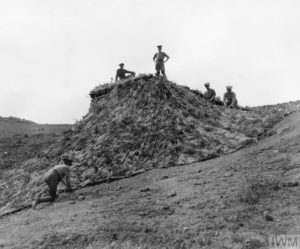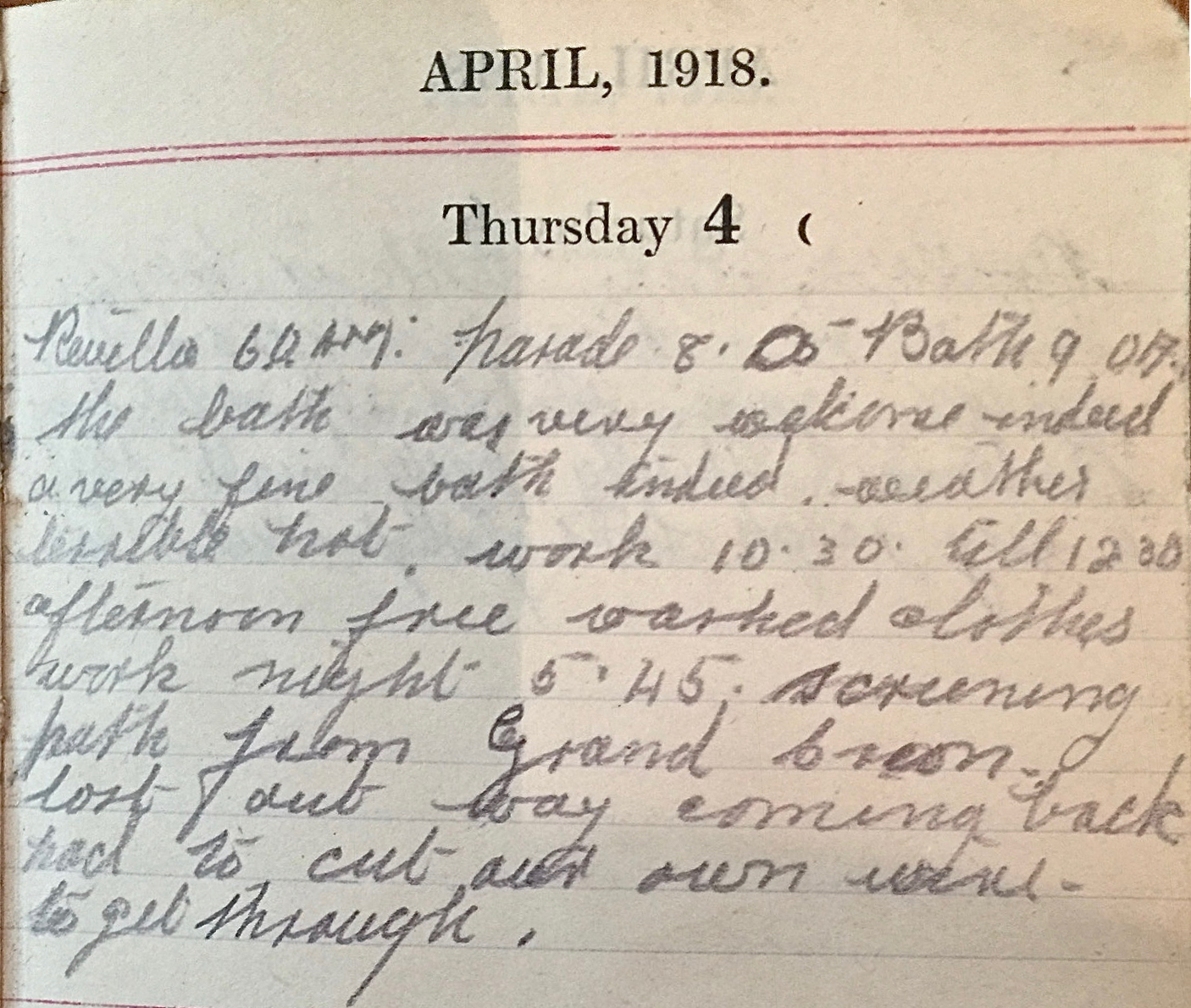Thursday April 4th, 1918
Reveille 6am, parade 8. Bath 9am, the bath was very welcome indeed. A very fine bath indeed. Weather terrible hot. Work 10:30 till 12:30. Afternoon free, washed clothes. Work night 5:45- screening path from Grand Couronne. Lost our way coming back – had to cut our own wire to get through.
Settling in
The baths in Bujuklu Ravine have been allocated to the Battalion for four days this week. Frank once again luxuriates at having a bath and washing his clothes. While about 5 kms from the front, they are clearly still in range of the enemy. All ranks have been told to wear steel helmets and anti-gas box respirators when leaving the camp, unless they are heading south of Table Hill.
Screening Paths

A couple of days ago, the BWD recorded, ‘The Battalion commenced work on Le Commandant trenches, and screening an alternative track from the eastern fork of Bujuklu Ravine to Castle Valley. …. Some heavy guns have been placed just north of Castle facing Kidney Camp near the old route from Bujuklu to Pillar via the western side of Castle Hill. Should these guns be heavily shelled, this route would be most dangerous, and alternative one being constructed will be most valuable.’

Today Frank is one of the troops who is working on screening this new route from the enemy. The Bulgars are well positioned on higher ground, including the Grand Couronne. From there they have a birds eye view of the British lines. Camouflage helps to keep men and equipment safe.
The first photograph, taken in France during the Spring Offensive of 1918, shows British soldiers erecting a camouflage screen beside a road at Abeele, near Poperinghe in May.*
The second photograph shows British troops constructing a shell-proof field gun position as part of the ‘birdcage’ defence line in Salonika in March 1916.^
Illtyd Davies recalls the effort required to dig in and camouflage his Newton Trench Howitzer when they moved to Torquay Ravine. ‘We dug down to a depth of twelve feet for the gun, and ammunition pit, both being connected by a tunnel. Quadrant irons were erected six and a half feet above the level of the pit floor, on top of which was poured four feet of concrete, and finished off with a layer of nearly three feet of rock and earth. It was necessary to dig a fan shaped ramp in front of the gun pit to allow for a good arc of fire. Only an enemy shell coming down the ramp could have put us out of action. That never occurred.’
This was no mean feat of engineering and physical effort, as Illtyd continues, ‘The cement and gravel for concreting was brought up at night by pack mules, quite a haulage job. Also three 40 gallon tanks were brought up by box limber, and dropped at the mouth of the ravine, then carried in by the gunners. A mound of earth was built around the tanks, to prevent shell splinters starting leaks.’¹
After all B Company’s hard work tonight, it is a pity that Frank and his comrades had to cut through their own wire to get back to camp!
13th (Service) Battalion War Diary – 4th April 1918 – Saida
Work and training as before. Programme of Work and Training 6th to 10th April (Appendix No 2) issued. L Sgt Young of the Army Lewis Gun School will instruct all the battalion Lewis Gun NCOs from the 5th to 9th instant from 08:30 to 12:30 hrs and from 14:30 to 15:30 hrs. 2nd Lt J Fazackerly (in hospital with damaged shoulder contracted on football field) is struck off effective strength with effect from 1-4-18.
References & Further Reading
* Image Q 8803 Copyright: Imperial War Museums
^ Image Q 31840 Copyright: Imperial War Museums
¹ ‘A Little Account’ by Illtyd Davies, from a collection of the ‘Salonika Campaign Society‘


